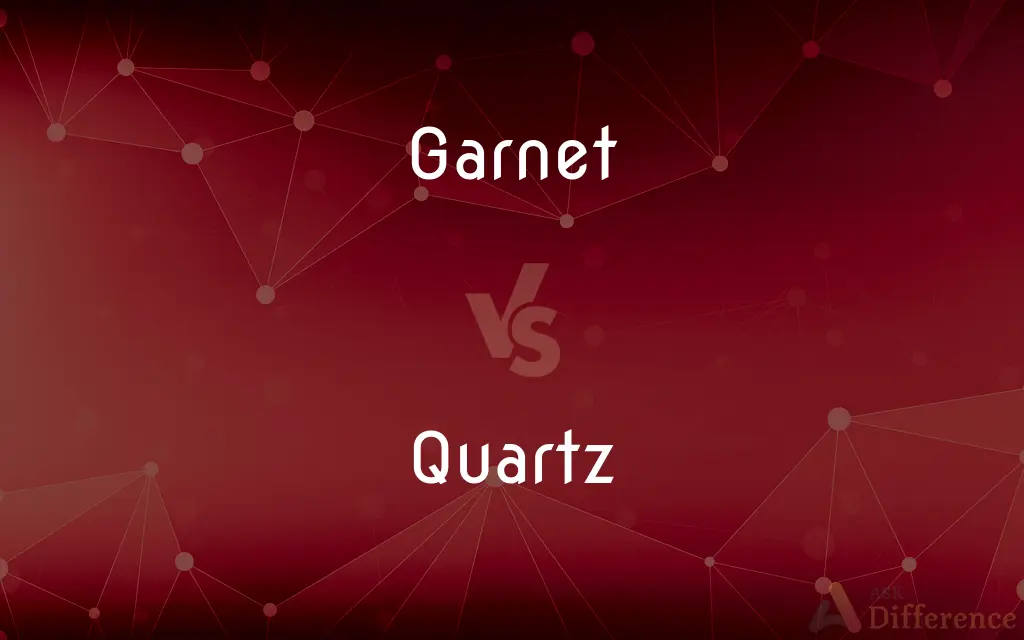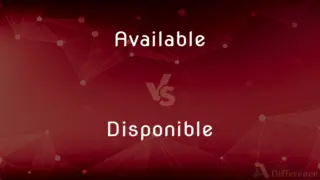Garnet vs. Quartz — What's the Difference?
By Maham Liaqat & Urooj Arif — Updated on March 12, 2024
Garnet is a group of silicate minerals known for their use in jewelry and abrasives, whereas quartz is a widespread mineral used in technology and as a gemstone, notable for its hardness and variety.

Difference Between Garnet and Quartz
Table of Contents
ADVERTISEMENT
Key Differences
Garnet encompasses a group of minerals with similar physical properties but differing in chemical composition, leading to a variety of colors and types. These minerals are commonly used in jewelry due to their luster and color diversity. Quartz, on the other hand, is a single mineral known for its durability and is found in many forms, including amethyst and citrine, making it versatile in both industrial applications and gemstone market.
Garnet is typically known for its deep red varieties, such as pyrope and almandine, which are highly sought after in the gemstone market. Quartz, whereas, offers a broader color range due to various impurities, including purple (amethyst), yellow (citrine), and clear (rock crystal).
In terms of hardness, garnets are generally hard (6.5 to 7.5 on the Mohs scale), making them durable enough for various jewelry settings. Quartz outmatches garnet slightly in this regard, with a hardness of 7 to 7.5, making it one of the most durable gemstones available.
From a metaphysical perspective, garnet is often associated with passion, energy, and health, making it a popular choice for those who believe in crystal healing. Quartz is attributed with amplifying energy and thought, as well as the effect of other crystals, making it a cornerstone in metaphysical practices.
Industrial applications differentiate them significantly; garnet is prized as an abrasive material due to its hardness and sharp edges, used in waterjet cutting and sandblasting. Quartz's piezoelectric properties make it invaluable in electronics and technology, including watches and oscillators.
ADVERTISEMENT
Comparison Chart
Composition
Silicate minerals, various compositions
Silicon dioxide
Color Variety
Deep reds, greens, oranges
Wide range, including purple, yellow, clear
Hardness (Mohs)
6.5 to 7.5
7 to 7.5
Common Uses
Jewelry, abrasives
Jewelry, technology, industrial
Metaphysical Properties
Associated with passion, energy
Amplifies energy and thoughts
Compare with Definitions
Garnet
A group of silicate minerals known for their rich colors and hardness.
The garnet necklace glowed with a deep red hue.
Quartz
A hard, crystalline mineral composed of silicon dioxide.
The quartz crystal sparkled under the shop light.
Garnet
Used as abrasives due to their hardness and sharp edges.
Garnet sandpaper is prized for its longevity and efficiency.
Quartz
Widely used in making jewelry and decorative items.
The artisan crafted a stunning quartz pendant.
Garnet
Utilized in waterjet cutting for its abrasive qualities.
Garnet abrasives make precision cuts in metal and stone.
Quartz
Essential in the tech industry for its piezoelectric properties.
Quartz oscillators regulate time in watches and clocks.
Garnet
Believed to energize wearers and promote health.
She wore a garnet bracelet for its purported health benefits.
Quartz
Varieties include amethyst, citrine, and rose quartz.
Her collection ranged from amethyst to rose quartz.
Garnet
Found globally, with significant sources in Africa and Asia.
The garnet stones in this piece were mined in Sri Lanka.
Quartz
Believed to enhance mental clarity and energy.
He kept a quartz crystal on his desk for focus.
Garnet
Garnets ( ) are a group of silicate minerals that have been used since the Bronze Age as gemstones and abrasives. All species of garnets possess similar physical properties and crystal forms, but differ in chemical composition.
Quartz
Quartz is a hard, crystalline mineral composed of silica (silicon dioxide). The atoms are linked in a continuous framework of SiO4 silicon-oxygen tetrahedra, with each oxygen being shared between two tetrahedra, giving an overall chemical formula of SiO2.
Garnet
Any of several common, widespread aluminum or calcium silicate minerals occurring in two internally isomorphic series, (Mg, Mn, Fe)3Al2Si3O12 and Ca3(Cr, Al, Fe)2Si3O12, generally crystallized, often embedded in igneous and metamorphic rocks, and colored red, brown, black, green, yellow, or white and used both as gemstones and as abrasives.
Quartz
A very hard mineral composed of silica, SiO2, found worldwide in many different types of rocks, including sandstone and granite. Varieties of quartz include agate, chalcedony, chert, flint, opal, and rock crystal.
Garnet
A dark to very dark red.
Quartz
(mineral) The most abundant mineral on the earth's surface, of chemical composition silicon dioxide, SiO2. It occurs in a variety of forms, both crystalline and amorphous. Found in every environment.
Garnet
(mineral) A hard transparent mineral that is often used as gemstones and abrasives.
Quartz
Crystal meth: methamphetamine hydrochloride.
Garnet
A dark red color, like that of the gemstone.
Quartz
A form of silica, or silicon dioxide (SiO2), occurring in hexagonal crystals, which are commonly colorless and transparent, but sometimes also yellow, brown, purple, green, and of other colors; also in cryptocrystalline massive forms varying in color and degree of transparency, being sometimes opaque.
Garnet
Of a dark red colour.
Quartz
Colorless glass made of almost pure silica
Garnet
A mineral having many varieties differing in color and in their constituents, but with the same crystallization (isometric), and conforming to the same general chemical formula. The commonest color is red, the luster is vitreous, and the hardness greater than that of quartz. The dodecahedron and trapezohedron are the common forms.
Quartz
A hard glossy mineral consisting of silicon dioxide in crystal form; present in most rocks (especially sandstone and granite); yellow sand is quartz with iron oxide impurities
Garnet
A tackle for hoisting cargo in or out.
Garnet
Any of a group of hard glassy minerals (silicates of various metals) used as gemstones and as an abrasive
Common Curiosities
What makes garnet a good abrasive material?
Its hardness and sharp edges allow garnet to be an effective material for sandblasting and waterjet cutting.
Are garnet and quartz used in technology?
Quartz is widely used in technology for its piezoelectric properties, unlike garnet, which is primarily used as an abrasive.
Can garnet and quartz be found together in nature?
Yes, garnet and quartz can coexist in metamorphic rocks, showcasing nature's diverse mineralogy.
Is quartz more durable than garnet?
Yes, quartz is slightly harder than garnet, making it more resistant to scratching and wear.
Can quartz be used in watches?
Yes, quartz is essential in watchmaking for its ability to regulate time with precision.
What is the most valuable type of garnet?
The most valuable garnets are those with rare colors, such as green demantoid garnet.
How do the metaphysical properties of garnet and quartz differ?
Garnet is associated with passion and energy, whereas quartz is believed to amplify energy and thought.
Do garnet and quartz have different forms?
While garnet comes in various mineral forms, quartz is a single mineral with various color variations due to impurities.
Is amethyst a type of quartz?
Yes, amethyst is a purple variety of quartz known for its beauty and clarity.
Are there synthetic versions of garnet and quartz?
Yes, both garnet and quartz can be synthetically produced for industrial and jewelry applications.
What distinguishes garnet from quartz in jewelry?
Garnet is known for its deep reds and durability, while quartz offers a wider color range and slightly greater hardness.
Can garnet be used in water purification?
Garnet's abrasive properties are more suited for cutting and sandblasting rather than water purification.
How do the uses of garnet and quartz differ in industrial applications?
Garnet is valued as an abrasive, while quartz's unique properties make it essential in electronics and technology.
What is the difference in the color range between garnet and quartz?
Garnet typically showcases deep reds, whereas quartz can appear in a wider spectrum of colors.
How are garnet and quartz sourced?
Both minerals are mined from the earth, with quartz being more abundant in the crust.
Share Your Discovery

Previous Comparison
Available vs. Disponible
Next Comparison
Lease vs. MortgageAuthor Spotlight
Written by
Maham LiaqatCo-written by
Urooj ArifUrooj is a skilled content writer at Ask Difference, known for her exceptional ability to simplify complex topics into engaging and informative content. With a passion for research and a flair for clear, concise writing, she consistently delivers articles that resonate with our diverse audience.















































